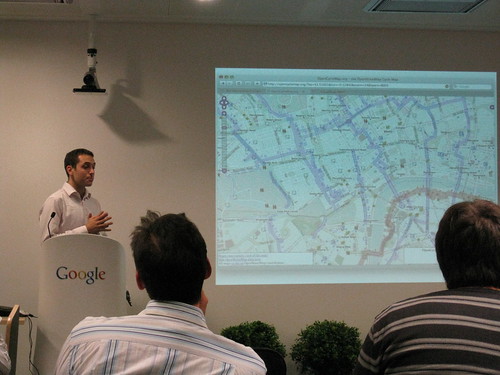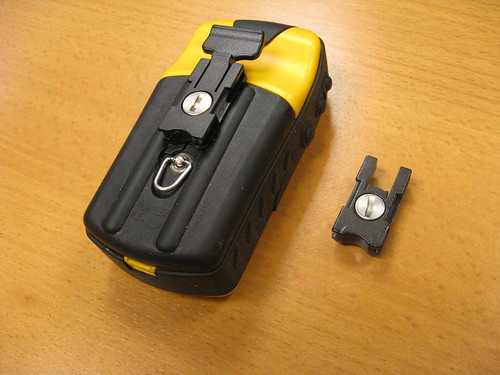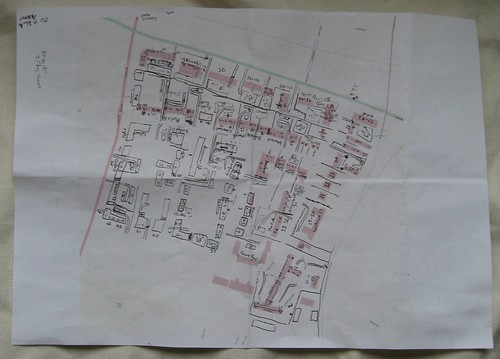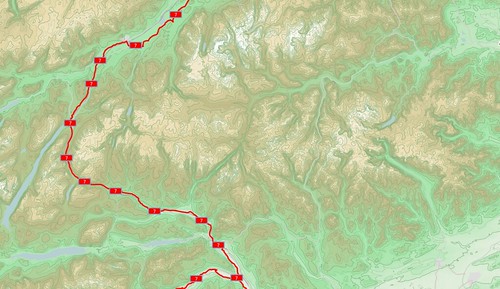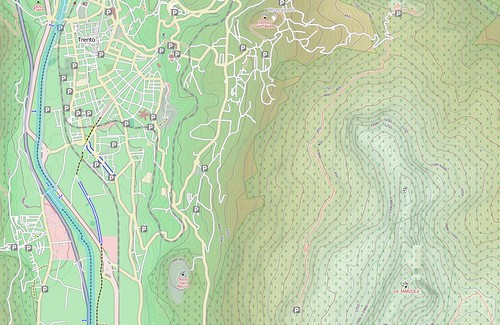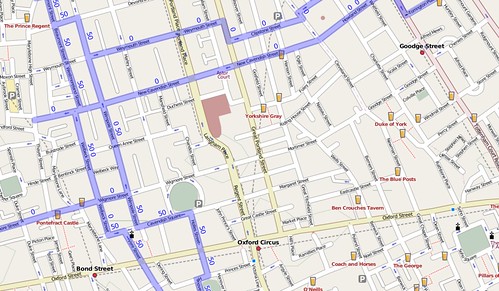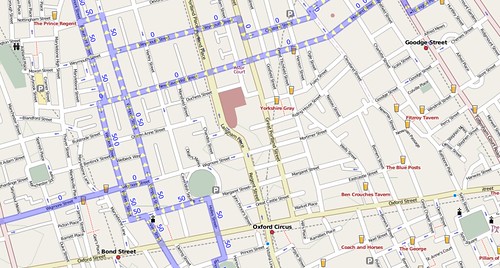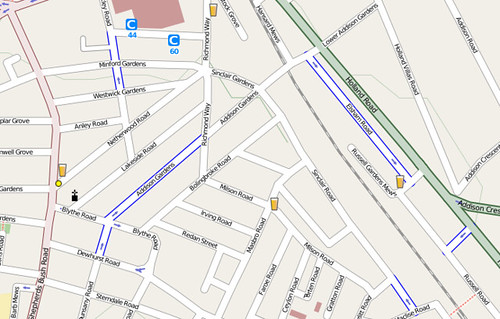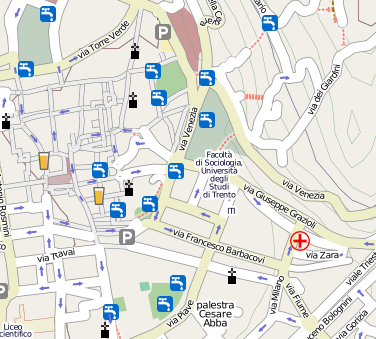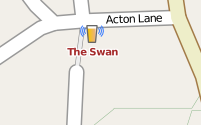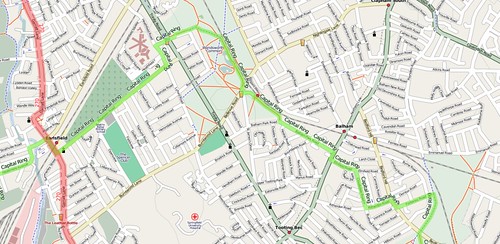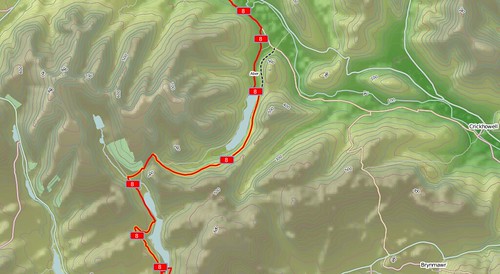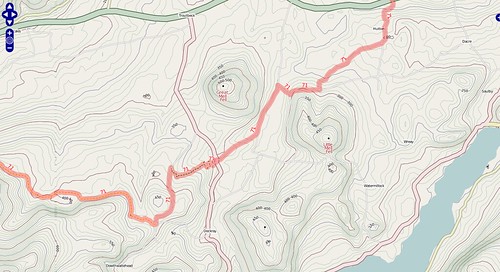Tag Archives: OpenStreetMap
- Southern Wales - National Cycle routes winding through nice and crinkly landscapes
- Mountain biking trails near Machynlleth
- Alpine routes near Bern, Switzerland
- Volcano spotting in the Philippines!
Walking Papers
When I got back from a long weekend yesterday I came across a new project from the legendary Michal Migurski - “Walking Papers”. The basic premise is that when doing OpenStreetMap (especially in partially mapped areas) we all spend a lot of time scribbling on print-outs of maps. For example see one created by Dave that I’ve blogged about before.
So wouldn’t it be great if you could then trace over the printout to enter the data into OSM? This is where Mike’s site comes in. If you print out your map from his site, it comes along with special pictures in the corners that embed some information about orientation and position. So when you scan it in an upload it to the site, it automatically knows where in the world that scan corresponds to and skews your scan to fit properly. And then you can simply trace over your notes with Potlatch to enter your data. More technical details are available from his weblog.
Even if you don’t want to scan back in, it’s actually a good interface for just printing maps for annotation. The only improvement I’d make to the site would be using OAuth to log into OpenStreetMap (so you don’t give walking-papers your password), but since that’s not implemented just yet on OpenStreetMap.org I can hardly blame Mike! I’ll be very interested to see how many people use the service - you can see what I did when testing it out or simply get started yourself!
This post was posted on 10 June 2009 and tagged OpenStreetMapInterviews and Awards
Interested in my prognostications on the world's best cycle map or OpenStreetMap in general? Then check out the recent interview I had with Ed Freyfogle from Nestoria. And while you're over there, check out Nestoria itself or even better their experimental OpenStreetMap version of Nestoria.
September 2008 was a pretty busy time for me, including speaking at the Society of Cartographer's Annual conference (slides are online, although of dubious merit without the narration), and running a session on OpenStreetMap at FOSS4G in Cape Town. In amongst all that, I was interviewed by Peter Eich, but thankfully he was happy for me to stick to English!
It was also the month that I received two awards for my work on OpenCycleMap - the first, a Commendation from the British Cartographic Society (coverage over on the CloudMade blog), and additionally the prestigious "Lolcat of awesomeness" from OSM itself - technically I got a part share of the API0.6 award too, but who's counting?
This post was posted on 5 January 2009 and tagged OpenStreetMapGMDLondon
Last night I went to the first meeting of the unwieldy-named London Geo/Mobile Developers Meetup Group, which was hosted by Google at their London HQ. The three talks are nicely summarised by Gary Gale in his blog post on the event, but I just wanted to include something I always like to see - giant slides showing the cycle map:
Nice. But as Mike mentions in the comments on that photo, there's still a lot of people need awakening to the powers of OpenStreetMap. BikeRadar mentions a campaign to try to persuade Google to add bike routes to their maps (can't think who "burlyc" might be...) - there's now 43,000 people signed the petition, when they could already have mapped all the bike paths onto OpenStreetMap instead. Really, as Nick discussed last night in his "Five things you can't do with online maps" talk, the ideas behind everyone sharing the same, standard, (frequently Google) map are becoming long in the tooth - all the interest and an increasing amount of "cool" stuff is coming from the open-source/crowd-sourced/OpenStreetMap world. We just need to keep spreading the word and getting more people involved.
This post was posted on 28 November 2008 and tagged OpenStreetMapReplacement Garmin eTrex Bike Clip
After some, umm, over-enthusiastic pinging by a volunteer at a recent OSM Mapping Party, the springy catch on my GPS's bike clip snapped off. In an attempt to get it fixed I left my brain out of gear and bought a second bike-mount kit from Amazon, but for reasons that still escape me only the handlebar-bit works with the 'x' models - in the kit there's a replacement back for units without the SD card that have the springy-bit molded on but that doesn't fit most models. So thinking back, I realised the removable clip I wanted had come in the original box, and as much as I fancy a new Legend HCx, I'm not paying hundreds of pounds just because of a two-pence piece of plastic broke!
But, good and surprising news came when I found a forum post that suggested phoning Garmin. Absolutely no hassle, they just sent me one in the post, for free. The cynical would say "just as well, it's their design flaw" but I just think it's nice when you stumble across some nice customer service - it makes a change. So if you're having the same problem (i.e. looking for a replacement 145-00709-00), just give them a call. And a tip of the hat goes to Amazon as well for their returns policy - even refunding the postage. Nice.
This post was posted on 21 November 2008 and tagged OpenStreetMap8 Minutes to Addressing
Last week I was watching a(nother) emergency-services documentary, "8 minutes to disaster", charting the trials and tribulations of an ambulance crew around Reading. The titular time-frame refers to the central mandated target (grumble government bureaucracy grumble) of how long the crews have between receiving a top-priority call and getting to the scene of the incident. In amongst much of the usual diabolical behaviour of drunken idiots in proximity to the NHS, there was one scene in particular that struck me. Mainly because I see most things through an OpenStreetMap filter nowadays, but...
The ambulance crew were responding to one such high-priority call, to respond to house 54 on a street of which I can't remember the name. They had been told it had a brown door, and when they found house 53 with the other half of the semi having a brown door, they jumped out and started pounding on it. A few seconds later a neighbour helpfully pointed out that it was an unmarked "53a", so they jumped in the ambulance, and set off again. Finding house 54 further down the street, they again jumped out, but the wrong colour on the door gave the first indication they were now on the wrong street, so jumping back in the ambulance and taking the other fork in the road got them to the correct house 54, with a brown door, and when they finally got to the patient, he was dead.
Now admittedly the patient in question had been dead for a few days, so 3 minutes of faffing around didn't cause him any significant ill effects, but when the first scene of the program was a man quite literally bleeding out, it shows such things can make all the difference. And I was surprised that the crew didn't have some massively overcomplicated, Accenture-procured multi-million pound GPS system that had house numbers built in. Actually, now I think about it, it's probably best they didn't - having been involved in the periphery of a few NHS IT projects, I can say they are the best way yet conceived of turning gob-smackingly large amounts of taxpayers money into things that simply just don't work. So these paramedics are probably better off with a consumer device that other consumers have willingly chosen to pay for with their own hard-earned cash, rather than involving bureaucrats, even though it can't help them find particular houses in a timely manner. I've seen similar issues on other emergency-services documentaries - police getting stuck in housing estates due to barriers simply not on their commercial GPSes.
So the OpenStreetMap tie-in comes from having spent the last few weeks starting to look into what comes next for OpenStreetMap after we've mapped every road, pub and cycle route in the country (hey, what seemed wildly ambitious just two years ago is becoming increasing routinely anticipated), and what's technically known as "Addressing" is part of that. It involves taking things one step further than just knowing where each road is, and getting to the point where we know where each house on each road is. Now that's a whole lot of work, but in bits and pieces across Europe OSM volunteers are starting to try things out. Dave has made a start around our area - see his sketch above - which is made up of fiendishly complex blocks of flats and Matt has done some stuff near our office. Frederik and Jochen from GeoFabrik have even made a tool for helping spot mistakes in the data. There's a lot of potential here, but a lot of hard work, but with everything in OSM it's a case of when, not if.
So here's hoping that in the next year or two we'll see consumer devices working from the world's best global community-generated open-source mapping-cum-routing-come-addressing-cum-everything-else dataset, helping ambulance drivers (and pizza delivery guys, for that matter) from here to, well, everywhere. And maybe it'll be only a few years between us saying "OpenStreetMap is pretty accurate, but I wouldn't use it for routing ambulances" to saying "OpenStreetMap is pretty accurate, especially for routing ambulances". It'll be awesome.
This post was posted on 12 November 2008 and tagged OpenStreetMap, TransportHill Colouring on the Cycle Map
Last week, in amongst a bit of a hosting problem, hill colouring went live on the cycle map. And it looks awesome!
Having something more pleasing than a flat grey background really helps put flesh on the skeleton of the contour lines, but it means that some stuff needs tweaking to fit. You can see the lovely new forest and wood styles on the image below - my very own forest pattern symbol, with a subtle green tinge and a solid border. The same area before can be found (here).
But wait - there’s more! In city centres, cycle routes can get quite complicated, and in some places have to go down one-way roads. You then end up with links that are only supposed to be followed in one direction - if you go the other way you might end up facing a no-entry sign (that you’re not really supposed to blithely ignore, politicians too for that matter). So you might end up with a confusing array of cycle routes, such as in central London:
… but no longer. The swiss-army-knife-like ‘relations’ to the rescue, which can give pointers as to which way you’re supposed to go. That gives us …
(Click the pictures for more detailed loveliness!)
But wait, that’s not all. Maybe your area doesn’t have any signed cycle routes and no cycle paths either. Or maybe you’ve got both, and also want cycle lanes marked. A nice little bit of blue casing on either side of the road shows which streets have cycle lanes.
And finally, the icon wizardry of Matt Amos has helped me out with showing more useful points of interest - we now have drinking water locations shown (here in Trento, Italy):
… which are probably a better idea than going to a pub. But what’s better than going to a pub for a nice refreshing beer? Well a pub with free wifi, of course!
And there’s been a million and one places added to the cycle map too, but far, far too many for me to list here. Enjoy!
This post was posted on 17 August 2008 and tagged OpenStreetMapLook ma, no hands!
It's becoming more and more widely accepted within OpenStreetMap that what we call 'routes' are best described with relations, instead of tagging the ways. It means that we can have two routes sharing the same stretch of road without any conflicts over numbering and so on. It's become well established in cycle-tagging, but I'm interested to see if it works elsewhere in different contexts.
During the first May bank-holiday weekend Dave and I scratched an itch that had been bothering me for a while. There are a few long distance paths through London, and the two that I've frequently come across are the Capital Ring and the London Loop, but we'd made no effort to join up the bits we had spotted. We set off to find the route of the Capital Ring from Wimbledon Common to Wimbledon Park, and accidently ended up following it all the way to Woolwich on the other side of the city.
So combining both the relations contexts and the Capital Ring expedition led me to try to render them, to see if it works. And it pretty much does. Dave had been tagging some bus routes during the development of Potlatch's relations handling code so I rendered them too. And lo and behold, other people have been doing the same here and there.
London overview (click the picture, then the all sizes link to see it in full):

And the title of the post? Well, it's not only that I was practising my (currently abysmal) cycling skills, it's also what I say when I'm experimenting without having thought things through beforehand. No prizes for spotting which map I ripped off for the style sheets! Currently I don't have any plans for making this a full service like the cycle map, which is still my main focus.
This post was posted on 29 May 2008 and tagged OpenStreetMapHill Shade Teaser
Time for another glimpse behind the scenes in the Cycle Map development!
Elevation colouring! Hill Shading! How cool is that? (N.B. If you ever hear me asking, then the answer is one of 'very' and 'awesome'. 'Meh' is a valid response, but don't let me hear you saying it!)
Now for all the OSM types there's a few caveats. The last time I posted a teaser (for contours) it took me six months to get things working properly. And there's plenty of things need fixing before the hillshading will go live, like some resolution issues, tiling issues, a minor problem involving the ocean shapefiles and so on - never mind choosing some colours that are a bit more subtle. So be patient!
This post was posted on 21 May 2008 and tagged OpenStreetMapMore cyclemap stuff
As usual, when the frequency of posts declines here, that just means there's more interesting things going on in the real world! I've also been trying to avoid writing yet another OSM post, but hey-ho, here's an update on the cycle map.
Lots more areas are now rendered since I blogged a month ago. Lyon, Vienna, Toronto, Vancouver, Antwerp, Almere, Neuss, Frankfurt, Furth, Karlsruhe, Berlin, Leuven, Bonn and Sydney have all been added along with overviews of some other countries. If there's somewhere else that you reckon could do with some more zoom levels, just leave a comment or send me an email.
Shelters are now rendered as can be seen in the forests near Bonn, and bike parking has been changed so that small capacity cycle stands show up as blue dots and only larger capacity bike parking areas show quite so predominantly! Previously, it could get quite cluttered as you can see when Tom Chance mapped the cycle parking around the parliament buildings in London. The changes were only partially implemented (or more accurately, I messed up some of the mapnik rules :-) ) so you'll need to wait a couple of days to see them working properly.
Also fixed was a UTF8 bug in the relations-handling code that meant that some recently-added routes weren't showing up properly at low zoom levels. We've also moved all the contours to the postgis database and stopped pre-rendering them - it turns out the IO hit of loading the transparent contour tiles from disk is greater than just re-rendering them for high zoom levels, and since most of the tiles are high zoom, that's where the time matters most.
This post was posted on 24 March 2008 and tagged OpenStreetMapOne Leg Longer than the Other
Contours are something that people have repeatedly asked me about - it’s even the closing subject on my radio interview a couple of weeks ago. This weekend I finally knuckled down and got to the bottom of a few outstanding problems (with thanks, as ever to Dave), and from today the cycle map takes a great leap forwards with world-wide contour coverage - well, “world-wide” as in everywhere that’s rendered on the cycle map.
Some of the highlights:
I’m really pleased with the way they’ve turned out, and I think this marks a step-change in functionality for cyclists planning their rides (or consoling themselves afterwards!). It does, however, take quite a lot of processing to generate these - it’s not for the faint-hearted or anyone without a quad-core machine overflowing with RAM and hard-disk space! The eagle-eyed amongst you may notice that all the roads have been tweaked and are more colourful now, but it’s still a cycling-focused map.
For those of you intrigued by the title - it comes from spending many years climbing up, down, and around mountains in Scotland - walking around the side of a mountain is known as “contouring” and gets pretty tiring after a while. Having adjustable legs would have been really helpful.
This post was posted on 18 February 2008 and tagged OpenStreetMapsubscribe via RSS

